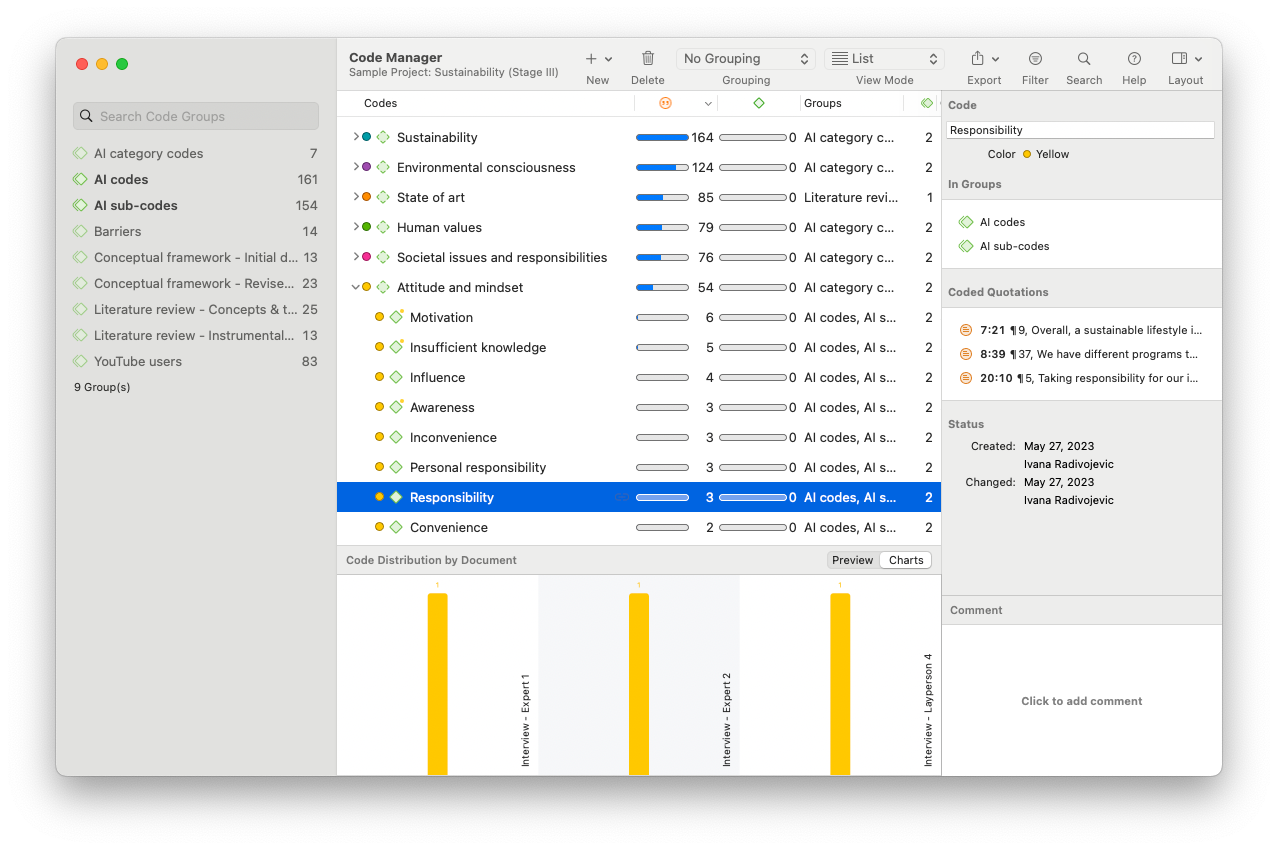- What is Thematic Analysis?
- Advantages of Thematic Analysis
- Disadvantages of Thematic Analysis
- Thematic Analysis Examples
- How to Do Thematic Analysis
- Thematic Coding
- Collaborative Thematic Analysis
- Thematic Analysis Software
- Thematic Analysis in Mixed Methods Approach
- Abductive Thematic Analysis
- Deductive Thematic Analysis
- Inductive Thematic Analysis
- Reflexive Thematic Analysis
- Thematic Analysis in Observations
- Thematic Analysis in Surveys
- Thematic Analysis for Interviews
- Thematic Analysis for Focus Groups
- Thematic Analysis for Case Studies
- Thematic Analysis of Secondary Data
- Thematic Analysis Literature Review
- Thematic Analysis vs. Phenomenology
- Thematic vs. Content Analysis
- Thematic Analysis vs. Grounded Theory
- Thematic Analysis vs. Narrative Analysis
- Thematic Analysis vs. Discourse Analysis
- Thematic Analysis vs. Framework Analysis
- Thematic Analysis in Social Work
- Thematic Analysis in Psychology
- Thematic Analysis in Educational Research
- Thematic Analysis in UX Research
- How to Present Thematic Analysis Results
- Increasing Rigor in Thematic Analysis
- Peer Review in Thematic Analysis
- How to cite "The Guide to Thematic Analysis"
Thematic Analysis Examples
Thematic analysis in qualitative research is a widely utilized qualitative research method that provides a systematic approach to identifying, analyzing, and reporting potential themes and patterns within data. Whereas quantitative data often relies on statistical analysis to make judgments about insights, thematic analysis involves researchers conducting qualitative data analysis to interpret various aspects (or themes) of the research topic they are exploring, offering rich, detailed, and complex accounts of the underlying meanings within the data. Thematic analysis is flexible and applicable across a diverse range of disciplines, underscoring its utility in providing insightful interpretations of nuanced datasets.
By focusing on examples of thematic analysis, this article aims to illustrate the practical steps involved in this method and showcase how it can be effectively applied to identify patterns and draw meaningful conclusions from qualitative data. Through this approach, readers will gain an understanding of the systematic nature of thematic analysis and its contribution to a deeper comprehension of research findings.

Thematic analysis example list
A typical thematic analysis report conveys researchers' identification of patterns or themes across various domains that answers their research questions. This robust analytical method is particularly valuable in the social sciences, where understanding human behavior, experiences, and societal structures is key. The following sections illustrate how various types of thematic analysis can be applied in different social science fields, each through a hypothetical qualitative research process.

Education: Understanding student motivation
In an educational context, a study was designed to explore the motivational drivers among high school students. Researchers conducted semi-structured interviews with a diverse group of 30 students, probing into their academic experiences, aspirations, and challenges. The thematic analysis of interview transcripts revealed distinct but interconnected themes.
Firstly, 'Teacher Influence' emerged as a critical theme, illustrating how educators' attitudes, feedback, and engagement levels affected student motivation. Positive reinforcement, constructive criticism, and personal attention were highlighted as aspects that fueled students' drive to learn and succeed. Another prominent theme was 'Peer Dynamics,' reflecting the impact of classmates and friends on students' motivation. This theme encompassed both positive influences, such as camaraderie and academic collaboration, and negative aspects like peer pressure and competition.
'Personal Aspirations' was identified as a third theme, indicating how students' goals and perceived future opportunities shaped their current academic engagement. Ambitions related to higher education, career prospects, and personal fulfillment were common motivators. Lastly, 'Learning Environment' emerged, encompassing aspects of the school setting that influenced motivation, including extracurricular activities, school facilities, and the overall educational atmosphere.
Identifying themes such as these underscores the complexity of student motivation, suggesting that multifaceted strategies are needed to enhance educational engagement and achievement.
Healthcare: Patient experiences in chronic disease management
In the healthcare sector, a qualitative study focused on patients with chronic conditions to understand their daily management challenges and support needs. Through interviews and diary entries from patients dealing with diseases like diabetes and hypertension, researchers conducted a thematic analysis to distill the patient experience into core themes.
The 'Healthcare Interaction' theme underscored the importance of patient-provider relationships, highlighting how empathy, communication, and responsiveness from healthcare professionals can significantly impact patient satisfaction and engagement in disease management. Another critical theme was 'Lifestyle Adaptation,' reflecting the ongoing adjustments patients make in diet, exercise, and medication routines. This theme highlighted the emotional and practical challenges of integrating disease management into daily life, as well as the strategies patients employed to cope with these changes.
'Social Support Networks' emerged as a core theme, illustrating the role of family, friends, and peer support groups in providing emotional encouragement, practical assistance, and motivation. The contrast between strong and lacking support networks provided insights into how social dynamics can influence disease management outcomes. 'Psychological Resilience' was identified as a theme capturing patients' mental and emotional responses to living with a chronic condition. This included coping mechanisms, attitudes toward illness, and the impact on personal identity and life perspective.
These themes offer a comprehensive view of the patient experience in chronic disease management, suggesting areas for improvement in healthcare practices and support systems.
Organizational behavior: Workplace culture and employee satisfaction
A study within organizational behavior examined how workplace culture influences employee satisfaction and retention. Through thematic analysis of focus group discussions with employees from various sectors, researchers identified key themes that shaped workplace experiences.
The 'Leadership Influence' theme highlighted the critical role of management styles, communication, and decision-making processes in shaping employees' perceptions of their workplace. Leadership approaches that fostered transparency, involvement, and recognition were associated with higher satisfaction levels. 'Work Environment and Resources' was another significant theme, emphasizing the importance of physical workspace, tools, and resources in employee productivity and contentment. Factors such as workspace design, technology access, and resource availability become important themes.
'Interpersonal Relationships and Team Dynamics' emerged as a theme reflecting the impact of collegial relationships and team cohesion on job satisfaction. Positive interactions, collaborative teamwork, and a supportive atmosphere were key drivers of employee engagement. 'Personal Growth and Development' captured employees' desire for opportunities to learn, advance, and take on new challenges. The availability of training programs, career advancement paths, and feedback mechanisms were crucial to employee fulfillment.
These findings underscore the multifaceted nature of workplace satisfaction, providing valuable insights for organizational development and employee engagement strategies.

Sociology: Social media's role in shaping public opinion
In a sociological study, researchers explored the influence of social media on public opinion regarding environmental issues. Content analysis and narrative analysis of discussions, posts, and comments across various platforms provided a semantic approach for thematic analysis, revealing how online narratives shaped perceptions and discourse. Meanwhile, the resulting themes support discussion for potential applications within social media and other forms of online discourse.
The 'Information Dissemination' theme illustrated the rapid spread of environmental information and misinformation, highlighting the dual role of social media as a tool for awareness and a source of confusion. 'Influencer Impact' emerged as a theme, underscoring the role of prominent figures and opinion leaders in shaping environmental discourse. The credibility and reach of these influencers significantly affected public engagement and perspective.
'Community Engagement' was also identified, showing how online communities mobilized around environmental causes, sharing experiences, organizing actions, and providing mutual support. This theme reflected the potential of social media to foster collective action and advocacy. Lastly, 'Emotional Engagement' captured the affective responses elicited by environmental content, including hope, anger, anxiety, and inspiration. These emotional reactions were key to driving awareness, concern, and action among the public.
Through these themes, the study illustrates the complex dynamics through which social media influences public opinion on critical issues, offering insights into the power of digital platforms in shaping societal discourse.
Takeaways for qualitative research and data analysis
While these thematic analysis examples span various fields within the social sciences, they share common methodological threads that highlight best practices in conducting effective thematic analysis. These commonalities can serve as valuable pointers for researchers aiming to employ thematic analysis in their work, regardless of their specific domain of study.
Systematic data engagement: Across all examples, a systematic approach to qualitative analysis is fundamental. Researchers personally engage in data collection and immerse themselves in the resulting data through repeated readings, enabling a deep familiarity to identify themes relevant to the data and research question. This immersion facilitates the initial coding process, where researchers employ data coding to capture data features relevant to the research questions. Researchers should approach their data systematically, ensuring thorough and consistent engagement to capture the depth and breadth of themes.
Iterative theme development: The examples illustrate that identifying themes is an iterative process. Preliminary themes are generated from initial codes that cluster similar data segments. These themes are then reviewed and refined, ensuring they accurately represent the data set. Researchers should be prepared to revisit their data and themes multiple times, refining their themes to ensure they are coherent, distinct, and meaningful. This iterative process is central to the rigor of thematic analysis.
Richness and complexity of themes: Thematic analysis, as demonstrated in these examples, excels in capturing the richness and complexity of qualitative data. Themes are not just surface-level categories; they encapsulate intricate patterns that provide deep insights into the data. Researchers should strive for generating themes that capture the complexity of their data, offering rich, detailed, and nuanced interpretations.
Contextual understanding: Each example underscores the importance of understanding the context from which the data are derived. Context shapes the data and the themes that emerge from them, influencing how researchers interpret and understand the identified patterns. Effective thematic analysis requires researchers to be acutely aware of their data's contextual backdrop, integrating this understanding into their analysis and interpretation.
Transparency and rigor: These examples demonstrate the need for rigor throughout the thematic analysis process. This includes maintaining detailed records of the process of coding data, providing clear definitions for each theme, and offering comprehensive explanations of how themes were derived from the data. Researchers should document their analytic decisions meticulously, ensuring their analysis is transparent and credible.
Triangulation and validation: These hypothetical studies exemplify the value of triangulating thematic analysis findings with other data sources, theories, or methods to enhance credibility. Researchers should consider using additional data sources or analytical methods to validate and enrich their thematic analysis findings, ensuring robust and trustworthy conclusions.
Reflective practice: Finally, these examples highlight the importance of a reflexive thematic analysis. Researchers must continually reflect on their own contexts, assumptions, and perspectives, considering how these might influence their analysis. By engaging in reflective practice, researchers can mitigate potential biases, enhance analytic rigor, and ensure their findings are a credible representation of the data.
These common threads across different thematic analysis examples provide a foundation for conducting robust and insightful thematic analysis. By adhering to these best practices, researchers can leverage thematic analysis to yield meaningful, impactful insights from their qualitative data.




